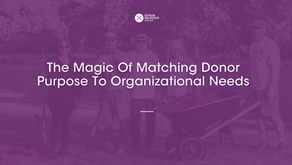The Art of Impact Reporting: A Guide to Inspiring Donors
- Lynne Wester

- May 29, 2024
- 3 min read

Welcome, fundraising and donor relations enthusiasts! Today, we embark on a thrilling journey into the heart of nonprofit excellence—exploring the captivating realm of impact reporting. So, grab your coffee, don your “Attitude of Gratitude” cap, and let's dive into the art of showcasing your organization's impact with flair!
Defining Impact Reporting – The DRG Way
At DRG, we believe in keeping things simple, so let's break down impact reporting in a way every novice can grasp. Impact reporting is a powerful tool to highlight the tangible, positive changes your organization brings to the world. It's not only about numbers—it's also about telling a compelling story of transformation, and placing donors in the roles of superheroes.
Using Impact Reporting to Ignite Engagement – The Secret Sauce
Is it possible to turn impact reporting into a beacon that draws supporters like moths to a flame? Yes! The “secret sauce” so to speak, lies in weaving great stories and impact into your narrative. Think "generosity vs. philanthropy," by emphasizing the emotional journey your donors embark on with each contribution. By focusing on extreme gratitude, you create a lasting connection, turning one-time donors into lifelong advocates.
Imagine a world where impact reporting is not just data on a page but a testament to the purpose-driven initiatives your organization champions. We're talking about stories that resonate with all donors. Craft a compelling narrative, and watch as it becomes a versatile masterpiece, shared across platforms, amplifying your reach and engagement.
Getting Started with Impact Reporting – DRG Style
Now, where to begin? – how do you kickstart your impact reporting adventure? Fear not—we're here to guide you through the process:
Define Your Impact Goals: Before you start reporting, clearly define what sort of reporting you will be doing. Are you planning to create reports for individual donors or more broad-based reporting to be delivered to multiple donors at once? Ideally, your organization should be doing a combination of both of these.
Determine the types of reports. Above, we mention individual and broad-based reports, but now you need to determine what types you will offer. Digital, printed, or a combination of both? What is meaningful to the donor? Do they like lots of financial data and metrics or do they prefer a story? Pay attention to the needs and wants of your donors, and your projects will be significantly more meaningful and productive.
Choose Your Metrics Wisely: Select metrics that align with your impact goals. Whether it's lives touched, communities transformed, or ecosystems restored – always pick metrics that tell a compelling story.
Craft a Compelling Narrative: Infuse your content with signature charm. You can often use humor to make your impact stories memorable. Whether it's a quirky video or a witty infographic, be sure to lean in your organization’s unique characteristics wherever you can.
Engage Your Audience: Leverage social media, newsletters, and events to engage your audience actively. Encourage them to share their thoughts, experiences, and ideas. Turn your impact reporting into a two-way street of communication.
DRG’s Guide to Best Practices for Impact Reporting
Behavior-Based Donor Relations: To make your reports more meaningful, it's important to incorporate insights into donor behavior. You can do this by showing donors how their contributions directly influence the positive changes that your organization achieves. This way, you can make donors the architects of the impact they want to see. By involving them in the process, you build stronger relationships with your donors and create more impactful reports.
ROE – Return on Engagement: While measuring the Return on Investment is important, it's equally important to measure your Return on Engagement. You can engage donors with interactive content, surveys, and behind-the-scenes glimpses, and by making your donors active participants in the journey, you’ll create a stronger bond with them and achieve greater impact. This will also help you understand the effectiveness of engagement activities and allow you to refine your approach for the future.
Innovative Storytelling: Rather than sticking to conventional reports, consider using videos, podcasts, and interactive visualizations to bring your impact to life. As disruptors, it's important to step away from the mundane and embrace innovative storytelling techniques. This will help you keep your audience hooked and wanting more. When using innovative storytelling techniques, you’re able to create more engaging and impactful reports that resonate with donors and stakeholders.
In conclusion, impact reporting is not simply a task—it's a powerful tool you can use to inspire, engage, and uplift. Embrace the process, infuse your reporting with purpose, and watch as your organization becomes a beacon of sustainable generosity.
You’re ready! It’s time to put on your innovator's hat, and start crafting impact reports that not only highlight results, but also inspire a wave of positive disruption in the nonprofit sector. The DRG way—because fundraising should always be as fun as it is meaningful!





